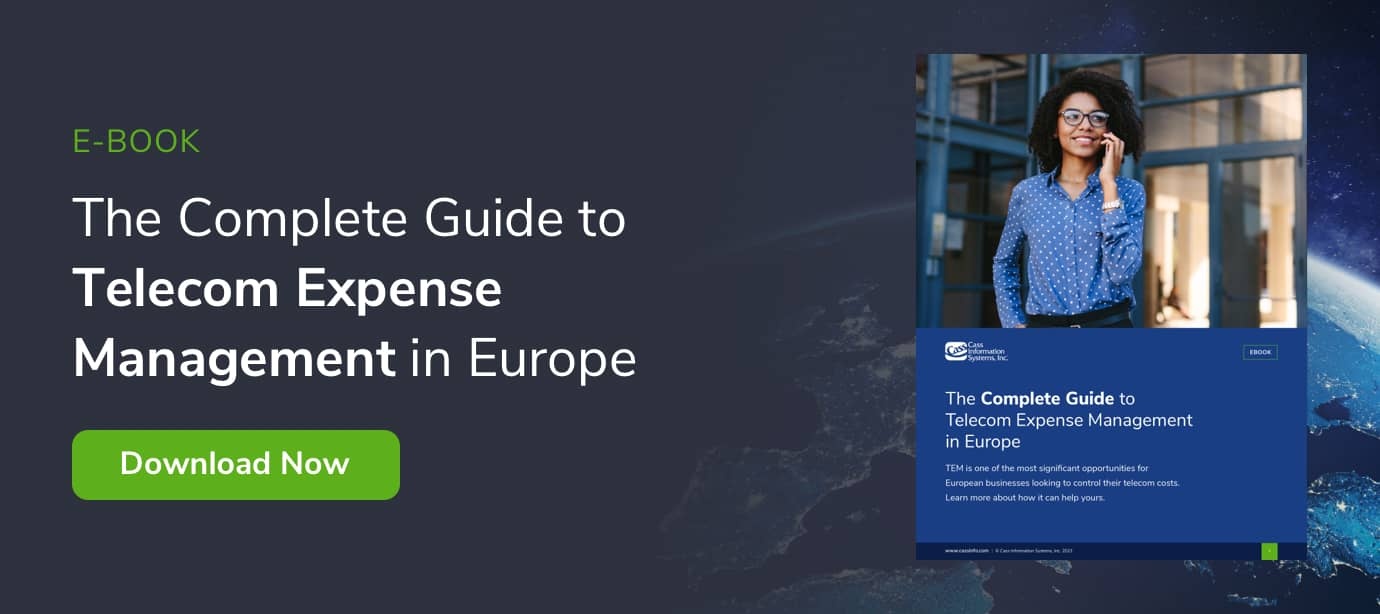The rise in remote working caused by COVID-19 is a trend that’s unlikely to be reversed. Over three-quarters of EU employees want to keep working remotely even after the pandemic restrictions lift. Working from home (WFH) is here to stay – and if enterprises aren’t careful, it can have a profound impact on telecom expenses.
If you don’t know where costs are coming from, they can quickly spiral out of control. Telecom expense management (TEM) enables enterprises to navigate this complexity and keep costs down. Yet despite its benefits, it hasn’t been fully embraced by many European organizations.
In this blog, we’ll explore what TEM is, how it helps you consolidate telecoms billing, and why it’s essential in a post-COVID world.
What is Telecom Expense Management (TEM)?
TEM is a service that enables large enterprises to get better visibility into key telecom management functions. This includes the entire mobility lifecycle of ordering, provisioning, cost management, support, and mobile device management. With more visibility, enterprises can improve processes and keep costs down.
Approaches to TEM vary depending on the provider. Many simply offer a software solution that optimizes processes. Others go one step further and provide a complete customer-driven service along with their TEM platform. They’ll give you guidance, expertise, and manual optimization to handle processes that software might miss.
As part of this service, the most effective TEM providers will continuously audit your telecom environment to identify opportunities for cost savings and inventory optimization. They’ll also help you negotiate new contracts to ensure you get the best rates and terms, facilitate secure and pain-free reimbursement for Bring Your Own Device (BYOD) programs, and more – acting as true partners at every step.
The Value of TEM and Why it Matters Now More Than Ever
Across an enterprise, unused features, plans, and policies quickly add up to a lot of wasted expense. The quickest, most direct TEM savings come from identifying billing errors and reducing inefficient spend on services you don’t need.
TEM also frees up more time for employees to focus on higher-value responsibilities by automating manual processes. And there are long-term indirect savings from improved policies, workflows, and decision-making, as TEM providers offer ongoing guidance and support.
TEM is already well-established in many areas of the world, with the U.S. being one of the most mature markets. It’s an essential practice for enterprise-level businesses – especially those with a global footprint. When you’re operating on that scale, you need in-region resources and knowledge to manage expenses effectively.
In Europe, however, working with TEM providers is less common, which means many organizations are missing out on major cost savings and operational benefits. And as a hybrid of office and remote working becomes the new standard, telecoms expenses are going to become a lot more complex – making TEM more vital than ever.
How TEM can Support Remote Working
In 2021 and beyond, your employees are going to expect instant, easy, and flexible access to tools that make remote working and real-time collaboration seamless. They’ll want the freedom to work from any device they choose, especially if you have a BYOD campaign in place.
As your mobile estate expands, working with a TEM provider will become crucial for ensuring your operations are secure, compliant, and cost-efficient. They offer services such as Unified Endpoint Management (UEM), which keeps your network of mobile users secure with instant updates – so your employees have the freedom to use any corporate-issued device you approve.
A TEM provider can also:
- Help you ensure you’re getting the best value from your contracts
- Manage the entire mobility lifecycle, from sourcing devices to disposing or recycling them
- Offer in-region knowledge and support across multiple countries
Managing MACD Remotely
Maintaining control of MACDs (an order to Move, Add, Change, or Disconnect a service) is a vital component of TEM. This could be a challenging task even in pre-pandemic circumstances. Keeping track of these activities when you have large amounts of users working from home is even more difficult.
For instance, when an employee exits the business, they won’t necessarily be on premises during the last days of their employment. So, you need a way to monitor which equipment must be collected and which services to disconnect when they leave. Otherwise, you could end up paying for resources that aren’t being used or that the person shouldn’t have access to.
By working with a TEM partner, you can track MACD activity within a single, centralized platform. This captures in-depth detail of your entire global telecom inventory. Internal teams can find the information they need in real-time and remain responsive to changes, so your telecoms spend is no longer left to grow unattended. This helps you achieve both immediate savings and long-term control of your telecom spend.
Working With the Right TEM Provider Makes Telecoms Billing in Europe Easier
You need a partner with the industry expertise to support you with the complexities of managing telecoms expenses in the new normal. This is where a TEM provider can help. They’ll work with you to audit your telecom invoices and bring all your processes and data into one centralized system. You can see exactly who is using what, where, and how much, even across a disparate and remote workforce. So, you can reduce costs, improve processes, and get the most value from your telecom estate.
To find out more about how TEM can benefit your business, read our latest free e-book, The Complete Guide to Telecom Expense Management in Europe.
Topics: TEM, Expense Audit, MACDs, BYON


